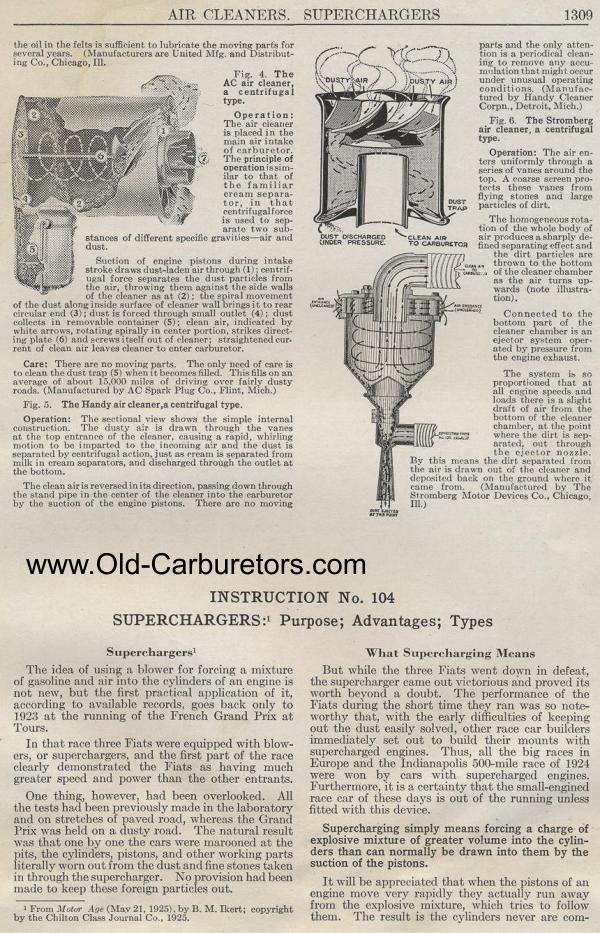AIR CLEANERS - SUPERCHARGERS
the oil in the felts is sufficient to lubricate the moving parts
for several years. (Manufacturers are United Mfg. and Distributing
Co., Chicago, Ill.
Fig. 4. The AC air cleaner, a centrifugal type.
Operation: The air cleaner is placed in the main air intake of
carburetor. The principle of operation is similar to that of the
familiar cream separator, in that centrifugalforce is used to separate
two sub-
stances of different specific gravities—air and dust.
Suction of engine pistons during intake stroke draws dust-laden
air through (1); centrifugal force separates the dust particles
from the air, throwing them against the side walls of the cleaner
as at (2); the spiral movement of the dust along inside surface
of cleaner wall brings it to rear circular end (3) ; dust is forced
through small outlet (4) ; dust collects in removable container
(5); clean air, indicated by white arrows, rotating spirally in
center portion, strikes directing plate (6) and screws itself out
of cleaner; straightened cur-rent of clean air leaves cleaner to
enter carburetor.
Care: There are no moving parts. The only need of care is to clean
the dust trap (5) when it becomes filled. This fills on an average
of about 13.000 miles of driving over fairly dusty roads. (Manufactured
by AC Spark Plug Co.. Flint, Mich.)
Fig. 5. The Handy air cleaner,a centrifugal type.
Operation: The sectional view shows the simple internal construction.
The dusty air is drawn through the vanes at the top entrance of
the cleaner, causing a rapid, whirling motion to be imparted to
the incoming air and the dust is separated by centrifugal action,
just as cream is separated from milk in cream separators, and discharged
through the outlet at the bottom.
The clean air is reversed in its direction, passing down through
the stand pipe in the center of the cleaner into the carburetor
by the suction of the engine pistons. There are no movingparts
and the only attention is a periodical cleaning to remove any accu-,
nmlation that night occur under unusual operating conditions. (Manufactured
by Handy Cleaner Corpn., Detroit, Mich.)
Fig. 6. The Stromberg air cleaner, a centrifugal type.
Operation: The air enters uniformly through a series of vanes around
the top. A coarse screen protects these vanes from flying stones
and large particles of dirt.
The homogeneous rota-
tion of the whole body of
air produces a sharply de-
fined separating effect and the dirt particles are thrown to the
bottom
,, of the cleaner chamber
as the air turns up-wards (note illustration).
Connected to the bottom part of the cleaner chamber is an ejector
system operated by pressure from the engine exhaust.
The system is so proportioned that at all engine speeds and loads
there is a slight draft of air from the bottom of the cleaner chamber,
at the point where the dirt is separated, out through the ejector
nozzle.
By this means the dirt separated from
the air is drawn out of the cleaner and
deposited back on the ground where it
came from. (Manufactured by The
Stromberg Motor Devices Co., Chicago
INSTRUCTION No. 104
SUPERCHARGERS:
1 Purpose; Advantages; Types
Superchargers
The idea of using a blower for forcing a mixture of gasoline
and air into the cylinders of an engine is not new, but the first
practical application of it, according to available records,
goes back only to 1923 at the running of the French Grand Prix
at Tours.
In that race three Fiats were equipped with blowers, or superchargers,
and the first part of the race clearly demonstrated the Fiats
as having much greater speed and power than the other entrants.
One thing, however, had been overlooked. All the tests had been
previously made in the laboratory and on stretches of paved road,
whereas the Grand Prix was held on a dusty road. The natural
result was that one by one the cars were marooned at the pits,
the cylinders, pistons, and other working parts literally worn
out from the dust and fine stones taken in through the supercharger.
No provision had been made to keep these foreign particles out.
c From :Motor Age (Mav 21, 1925), by B. M. Ikert; copyright by
the Chilton Class Journal Co., 1925.ghat Supercharging Means
But while the three Fiats went down in defeat, the supercharger
came out victorious and proved its worth beyond a doubt. The
performance of the Fiats during the short time they ran was so
note-worthy that, with the early difficulties of keeping out
the dust easily solved, other race car builders immediately set
out to build their mounts with supercharged engines. Thus, all
the big races in Europe and the Indianapolis 500-mile race of
1924 were won by cars with supercharged engines. Furthermore,
it is a certainty that the small-engined race car of these days
is out of the running unless fitted with this device.
Supercharging simply means forcing a charge of explosive mixture
of greater volume into the cylinders than can normally be drawn
into them by the suction of the pistons.
It will be appreciated that when the pistons of an engine move
very rapidly they actually run away from the explosive mixture,
which tries to follow them. The result is the cylinders never
are come
Previous page 1927
Supplement Home Next page 
|
